Polaron Dynamics in Mott Insulators
Broad-line NMR is an indispensable tool in the study of strongly electron correlated systems (SECS), as it provides atomic scale information on the electron-electron spin correlations and electron spin ordering. On the basis of 139La NMR combined with HRTEM measurements in the temperature range 3K-1000K, we have monitored the formation of zig-zaged Mn3+-Mn4+ polarons, the so called CE-type polarons in the paramagnetic phase (PM) of the prototype manganite La0.67Ca0.33MnO3. By lowering temperature, correlated polarons are shown to dominate the electron spin dynamics in the Ferromagnetic (FM) phase, leading to a bad metallic FM phase; however, at very low temperatures they appear to be organized into a unique quantum spin liquid-crystal (SLC) phase. This is new insight into the physics of doped Mott insulators, which becomes possible only with the use of NMR.“Polaron freezing and the quantum liquid-crystal phase in the ferromagnetic metallic La0.67Ca0.33MnO3. A NMR and HRTEM study in the temperature range 3.2K to 1000K”, Panopoulos, N., et al. npj Quantum Materials 3, 20 (2018).

